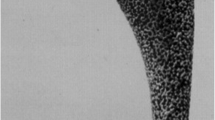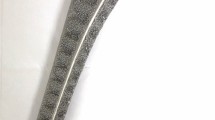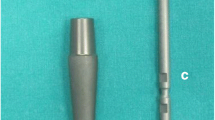Abstract
Two groups of 53 cementless total hip replacement were compared retrospectively after 3–7 years average follow-up. The design of femoral components in cementless total hip arthroplasty has progressed with emphasis placed on prevention of stress shielding in recent years. However, whether the stress shielding is actually prevented with the progress in stem design is open to debate. The purpose of this manuscript is to study radiologically whether the progress of the stem design in cementless total hip arthroplasty really reduced stress-shielding. We used 24 Omnifit stems and 29 Lord Mark ll stems. They were investigated in accordance with Gruen's classification with respect to osteolysis, atrophy, cortical hypertrophy and pedestal bone formation at the tip of the stem. With the Omnifit stem less bone atrophy was produced at the proximal femur but hypertrophic changes at the distal femur were more pronounced compared with Lord Mark II. It is concluded that the press-fit design does not prevent stress shielding completely.
Résumé
Deux groupes de 53 remplacements complets de la hanche sans ciment ont été rétrospectivement comparés après un suivi d'environ 3,7 ans. Le design et la conception des composants fémoraux dans l'arthroplastie totale de la hanche sans ciment a évolué au cours des dernières années avec l'accent mis tout particulièrement sur la prévention du “stress shielding”. Toutefois, la question de savoir si les progrès enregistrés dans le design de la tige prothétique permettent de prévenir le “stress shielding” demeure ouverte et peut être débattue.
Le but de cette étude est d'étudier du point de vue radiologique si les progrès au niveau du design de la tige dans le cas d'une arthoplastie totale de la hanche sans ciment réduisent réellement le “stress shielding”.
Nous avons utilisés 24 tiges fémorales Omnifit et 29 tiges fémorales Lord Mark II. Au regard de l'ostéolyse, de l'atrophie, d'une hypertrophie corticale et de la base, d'une formation osseuse à l'extrémité de la tige prothétique, on a étudié ceux-ci conformément à la classification des zones de Gruen.
Avec les tiges fémorales Omnifit, moins d'atrophies osseuses ont été produites au niveau du fémur proximal mais les modifications hypertrophiques au niveau du fémur distal étaient plus marquées, par comparaison avec les tiges fémorales Lord Mark II. Nous en concluons que le design “press-fit” ne peut prévenir totalement le “stress shielding”.
Similar content being viewed by others
References
Amstutz HC, Nasser S, More RC, Kabo JM (1989) The anthropometric total hip femoral prosthesis. Preliminary clinical and roentgenographic findings of exact-fit cementless application. Clin Orthop 242: 104–119
Bugbee WD, Culpepper II WJ, Engh JR A, Engh SR C (1997) Long-term clinical consequences of stress-shielding after total hip arthroplasty without cement. J Bone Joint Surg 79-A: 1007–1012
Engh CA, Bobyn JD, Glassman AH (1987) Porous-coated hip replacement. The factors govering bone ingrowth, stress shielding, and clinical results. J Bone Joint Surg 69-B: 45–55
Engh CA, Glassman AH, Suthers KE (1990) Roentgenographic assessment of the biologic fixation of porous-surfaced femoral components. Clin Orthop 257: 107–128
Engh CA, Glassman AH, Suthers KE (1990) The case for porous-coated hip implants. The femoral side. Clin Orthop 261: 63–81
Gruen TA, McNeice GM, Amstutz HC (1979) “Modes of Failure” of cemented stem-type femoral components. A radiographic analysis of loosening. Clin Orthop 141: 17–27
Mont MA, Hungerford DS (1997) Proximally coated ingrowth prosthesis. A review. Clin Orthop 344: 139–149
Ohashi H, Hirohashi K, Yamano Y (2000) Factors influencing the outcome of Chiari pelvic osteotomy: a long-term follow-up. J Bone Joint Surg. 82-B: 517–525
Toyama H, Endo N, Sofue M, Dohmae Y, Takahashi HE (2000) Relief from pain after Bombelli's valgus-extension osteotomy, and effectiveness of the combined shelf operation. J Orthop Sci 5(2): 114–123
Van Rietbergen B, Huiskes R, Weinans H, Summer DR, Turner TM, Galante JO (1993) The mechanism of bone remodeling and resorption around press-fitted the stems. J Biomech 26(4–5): 369–382
Whiteside LA, Arima J, White SE, Branam LB, McCarthy DS (1994) Fixation of the modular total hip femoral component in cementless total hip arthroplasty. Clin Orthop 298: 184–190
Author information
Authors and Affiliations
Corresponding author
Rights and permissions
About this article
Cite this article
Yasuma, M., Nozawa, M. & Kurosawa, H. Difference of the roentgenographic findings between recent and old cementless total hip arthroplasty femoral component. Eur J Orthop Surg Traumatol 11, 165–168 (2001). https://doi.org/10.1007/BF02747660
Received:
Accepted:
Issue Date:
DOI: https://doi.org/10.1007/BF02747660




